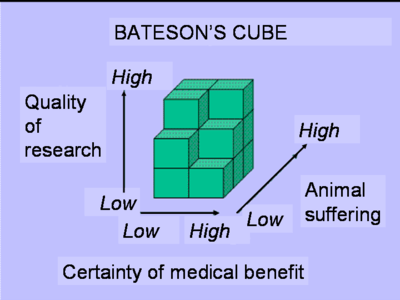Bateson's cube
From Wikipedia, the free encyclopedia

The cube has 3 axes measuring suffering, certainty of benefit and quality of research. If the research is high quality, certain to be beneficial and not going to inflict suffering then it will fall into the hollow section (top front) meaning research should proceed. Painful, low quality research with lower likelihood of success will be bottom back in the solid and should not proceed. Most research will not be clear cut but the rule is solid should not continue, hollow should.
Bateson's cube is a model of the cost-benefit analysis for animal research developed by Professor Patrick Bateson, president of the Zoological Society of London. [1][2]
Bateson's cube evaluates proposed research through three criteria:
- the degree of animal suffering,
- the quality of the research,
- the potential medical benefit.
Bateson suggested that research that does not meet these requirements should not be approved or performed, in accordance with the Animals (Scientific Procedures) Act 1986. It is not intended as a formal model for optimal trade-offs, but rather a tool for making judicial decisions, since the three axes are not in a common currency.[3] The third criterion also does not necessarily have to be medical benefit, but could be a wider form of utility. [4]
References
- ↑ P. Bateson, When to experiment on animals. New Scientist, 109 (1986), pp. 30–32
- ↑ P. Bateson, P. Biggs, A. Cuthbert, I. Cuthill, M. Festing, E.B. Keverne, S. King, C. Page, O. Petersen, N. Rothwell, M. Rushworth, V. Walsh, O. Roberts. The Use of Non-human Animals in Research: a Guide for Scientists. The Royal Society, Policy Document 01/04 The Royal Society, London (2004)
- ↑ P. Bateson. Ethics and behavioural biology. Advances in the Study of Behavior, 35 (2005), pp. 211–233
- ↑ Innes C. Cuthill, Ethical regulation and animal science: why animal behaviour is not so special. Animal Behaviour. Volume 74, Issue 1, July 2007, Pages 15–22
This article is issued from Wikipedia. The text is available under the Creative Commons Attribution/Share Alike; additional terms may apply for the media files.